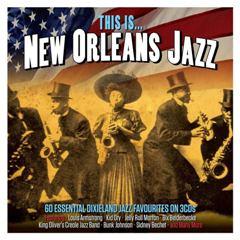This Is ... New Orleans Jazz (2019) CD2
This Is ... New Orleans Jazz (2019) CD2

1. King Porter Stomp - Jelly Roll Morton 2. Whispering - Red Nichols 3. Alexander's Ragtime Band - Bunk Johnson 4. Dippermouth Blues - George Lewis & His New Orleans All Stars 5. Somebody Stole My Gal - Kid Ory 6. My Little Isabel - Johnny Dodds' Washboard Band 7. Potato Head Blues - Louis Armstrong 8. Scissor Grinder Joe - Doc Cook's Dreamland Orchestra 9. Chinaman Blues - Erskine Tate's Vendome Orchestra 10. Down At Jaspers Bar-B-Que - Frankie 'Half Pint' Jackson 11. Swanee River - Kid Ory 12. Tiger Rag - The Firehouse Five Plus Two 13. When I Leave The World Behind - Bunk Johnson & His New Orleans Jazz Band 14. Blue Washboard Stomp - Johnny Dodds' Washboard Band 15. You're Driving Me Crazy - Bob Crosby 16. Adams Apple - Jimmy Blythe & His Ragamuffins 17. Tin Roof Blues - George Lewis & His New Orleans All Stars 18. Get It Right - Kid Rena's Delta Jazz Band 19. Grandpa's Spells - Jelly Roll Morton 20. Alligator Hop - King Oliver's Creole Jazz Band
Dixieland is an early form of jazz that originated in New Orleans sometime around the early 1900s. It is differentiated from Mississippi jazz by its instrumentation and size; where Mississippi and rural southern jazz generally had just a solo performer with a guitar, Dixieland typically featured a larger group with a soloist. Its roots are different too; rural jazz generally came from plantation songs, whereas Dixieland was more an amalgam of brass bands, military bands, and ragtime, amongst others.
The name comes from the first commercially successful record of the genre, the Original Dixieland Jass Band (yes, jazz was once spelled 'jass'). Its popularity peaked in the 1920s, and it essentially fizzled out in the 1930s when swing jazz began to take over. Like other forms of jazz, Dixieland migrated from the south to Chicago and eventually New York (Harlem specifically).
The Dixieland sound is similar to that of a military marching band, with driving rhythms and powerful brass sections. The melody is typically played by a solo high brass sound, the rhythm section keeps the harmony going, and the other front line instruments improvise melodic material around the soloist. The rhythm section generally consists of some of the following: a strummed string instrument (guitar or banjo), a low instrument (string bass or tuba), piano, and a drum. Front line instruments are trumpets, trombones, and clarinets. ---study.com
download (mp3 @320 kbs):
yandex mediafire ulozto gett bayfiles








